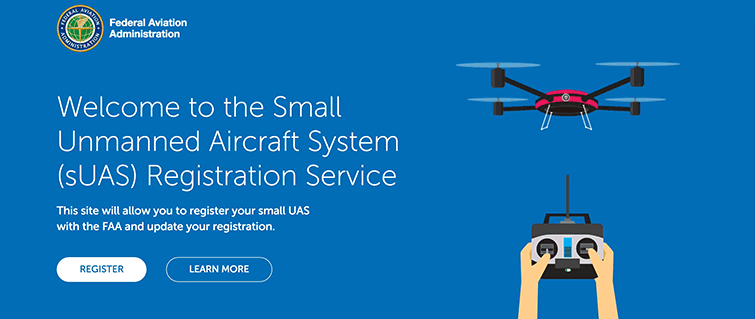
How to Get a Pilot Certification for Commercial Drone Use
Fly your drone for commercial use with the FAA’s new Remote Pilot Certificate. Here’s everything you need to know about the new process.
Top image via Shutterstock
Commercial drone use is now officially FAA official. That’s right, it’s now legal to fly your drone for commercial use in the United States. The Federal Aviation Administration has released the steps to attaining a UAS Remote Pilot Certification as well as any additional commercial waivers.
For those solely flying for hobbyist recreation, the pilot certification is not required. However, all pilots must register their Small Unmanned Aircraft Systems with the FAA. All aircraft weighing over 0.55 lbs must be registered and tagged with its registration number. It’s a simple online process that costs $5. If you want to fly outside of the US, or if your aircraft weighs more that 55 lbs, you must use the paper registration form.
Hobbyist UAS Flight
If you have no intention to ever sell your footage or photos, the use of your UAS falls under the hobbyist category. This allows you to fly your aircraft for fun. Hobbyists can still upload and share their footage online to sites like YouTube and Vimeo. For filmmakers wanting to make a short film, they may fall under hobbyist use if there are no financial gains. They must be made not for profit.
Hobbyist pilots must be a U.S. Citizen or legal permanent resident over the age of 13.
Registering Hobbyist Aircraft
For US-based flights with aircraft weighing 0.55-55 lbs (250 grams-25 kilograms), you can register your aircraft online.
- Go to registermyuas.faa.gov
- Click Register
- Create an Account (Must be 13 years or older)
- Select Model Aircraft
- Enter your personal information, click Proceed to Checkout
- Enter your payment information for the $5 Fee, click Submit
- Print a copy of your certificate for your records
- Write the Registration Number on the body of your UAS (Drone)

Image: Phantom 4 via DJI
Hobbyist Flight Rules
- Fly at or below 400 feet
- Keep the UAS (Drone) in visual line-of-sight at all times
- Know the airspace requirements of your location
- Daylight-only operations (30 minutes before official sunrise to 30 minutes after official sunset)
- Do NOT fly near airports
- Do NOT fly near other aircraft
- Do NOT fly over crowds of people
- Do NOT fly over stadiums or sporting events
- Do NOT fly near emergency response efforts
- Do NOT fly under the influence
- Do NOT fly at speeds at or over 100mph
- No operations from a moving aircraft
- No operations from a moving vehicle, unless the operation is over a sparsely populated area
- No careless or reckless operations
- No carriage of hazardous materials
 Image via Shutterstock
Image via Shutterstock
Commercial Flight and UAS Remote Pilot Certification
If you intend to sell your aerial photos and footage, you fall under commercial use of an aircraft. While the rules and guidelines are similar to hobbyists, commercial use requires a Small UAS Remote Pilot Certification. Essentially, this is a much lower level of a pilot’s license, similar to a driving permit versus a driver’s license. At around $150 for testing, it’s much cheaper than a pilot’s license too.
For those familiar with Section 333 Exemptions, that convoluted process is no longer necessary for drones under 55lbs. If your aircraft weighs more than 55lbs, you will need both a UAS Remote Pilot Certification and a Section 333 Exemption.

Image via FAA
Requirements for UAS Remote Pilot Certification
- Must be 16 years of age or older
- Able to read, speak, write, and understand English
- Be in a physical and mental condition to safely operate a small UAS
- Must pass an Aeronautical Knowledge Test at an FAA-approved testing center (every two years)
- Must undergo a Transportation Safety Administration TSA background security check
- File FAA Form 8710-13 for a remote pilot certificate with a small UAS rating through the Integrated Airman Certification and Rating Application (IACRA)
Steps to Pass the Aeronautical Knowledge Test
- Read and study the following documents:
- Airman Certification Standards
- Remote Pilot Knowledge Test Guide
- Remote Pilot Small UAS Study Guide
- Pilot’s Handbook of Aeronautical Knowledge
- Part 107 Advisory Circular
- Alternatively, you can supplement your studies with the Drone Pilot (UAS) Test Prep App iOS ($39.99) | Android ($49.99)
- Take the Free FAA Part 107 Course and Aeronautical Knowledge Practice Test (create an FAA account to view)
- Register and take the Aeronautical Knowledge Test at a Nearby FAA-approved testing facility
- Pass the 60-question multiple choice Aeronautical Knowledge Test with a minimum score of 70%
- Complete FAA Form 8710-13 for a Remote Pilot Certificate using the FAA IACRA system.
- Register with the FAA IACRA
- Login with username and password
- Click on Start New Application
- Application type — Pilot
- Certifications — Remote Pilot
- Other path information
- Start application
- Follow application prompts
- Enter the 17-digit Knowledge Test Exam ID
- Sign the application electronically and submit
- Wait 6-8 weeks for processing
- Repeat the test after two years
UAS Waivers
If your drone operations don’t meet the new standards, you can apply for a waiver from the FAA. Waivers could permit you to fly at night, beyond visual line-of-sight, or above the 400ft ceiling. The FAA has confirmed that they have already processed 76 waivers within the first days of the new regulations. Processing time depends on the complexity of the request — however, the agency strives to respond within 90 days. You can read more about UAS waivers here.
Have you gone through the FAA certification process? Share your experience in the comments below.






